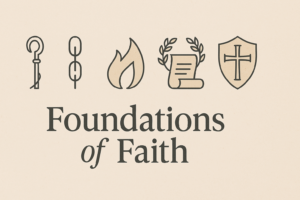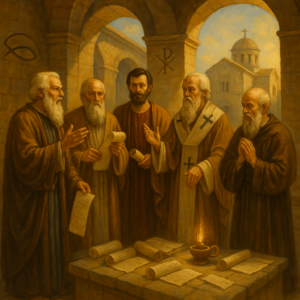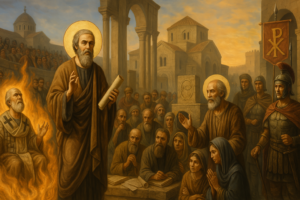Estimated reading time: 7 minutes
Key Takeaways
- The early church fathers played a pivotal role in shaping Christian doctrine and defending the faith against heresies.
- Their writings provide a crucial link between the apostolic age and later church developments.
- Understanding their lives and teachings helps modern believers appreciate the roots of their faith.
- Figures like Ignatius of Antioch emphasized the importance of church unity and combating false teachings.
- The challenges faced by early Christian communities influenced the development of key theological concepts.
Historical Context of the Early Church Fathers
The Apostolic Age
The story of the early church fathers begins in the period immediately following the New Testament era. As the original apostles died, a new generation of leaders emerged to guide the growing Christian communities. These apostolic church fathers were often direct disciples of the apostles themselves, creating a living link to Jesus’s original followers.
Figures like Clement of Rome, who may have known Peter and Paul, represent this crucial transition from apostolic to post-apostolic Christianity. Their proximity to the original apostles gave their teachings special authority in the eyes of early believers.
Development of Early Christian Communities
During the first few centuries after Christ, Christianity spread rapidly throughout the Roman Empire despite facing significant challenges. The early church fathers’ history is marked by periods of intense persecution under emperors like Nero, Domitian, and Diocletian.
These communities also faced internal challenges as they worked to articulate their beliefs coherently. Without centralized authority, different interpretations of Christian teaching emerged, sometimes leading to conflicts that the church fathers addressed in their writings.
The expansion of Christianity occurred within the context of the Roman Empire’s vast territory, which facilitated travel and communication while simultaneously presenting dangers for those identified as Christians. Urban centers became important hubs for Christian communities, with cities like Rome, Alexandria, Antioch, and Carthage developing influential theological traditions. For more on this period, read about the early church fathers.
Role of the Apostolic Fathers’ Writings
The apostolic fathers’ writings represent the earliest Christian literature outside the New Testament, created roughly between 90-160 AD. These early Christian writings played a crucial role in preserving and transmitting apostolic teaching to subsequent generations.
Their works addressed practical issues facing early Christian communities: how to organize church leadership, conduct worship, respond to persecution, and maintain doctrinal purity. Unlike later theological treatises, these writings often took the form of letters addressing specific situations, similar to Paul’s epistles in the New Testament.
The Didache, one of these early documents, provided instructions for Christian living, baptism, fasting, prayer, and the Eucharist. Other important early Christian writings include the Shepherd of Hermas, the Epistle of Barnabas, and the epistles of Clement, Ignatius, and Polycarp.
These documents reveal how the early church understood and applied apostolic teaching in their communities, forming a bridge between the New Testament and later church developments. Discover more about the value of reading these writings in this insightful article by John Wesley: The Value of Reading the Writings of the Early Church Fathers.
Profiles of Key Early Church Fathers and Their Writings
Saint Ignatius of Antioch
Background
Saint Ignatius of Antioch (c. AD 35-107) served as the third bishop of Antioch in Syria. According to tradition, he was a disciple of the Apostle John. His impact on early Christianity is particularly significant because his writings provide a window into the developing church structure and theology in the post-apostolic era.
Ignatius’s life ended in martyrdom when he was condemned to death during Emperor Trajan’s reign. Rather than lamenting his fate, Ignatius embraced his martyrdom, viewing it as an opportunity to imitate Christ’s suffering.
Ignatius of Antioch’s Writings
The Ignatius of Antioch writings that survive today consist of seven authentic letters written while he was being transported to Rome for execution. These letters were addressed to Christian communities in Ephesus, Magnesia, Tralles, Rome, Philadelphia, and Smyrna, plus a personal letter to Polycarp, bishop of Smyrna.
Key themes in his letters include:
- Strong emphasis on church unity and the importance of obedience to bishops
- Warnings against heretical teachings, particularly Docetism (the belief that Jesus only seemed to be human)
- The value of martyrdom as a witness to faith in Christ
Frequently Asked Questions
Who were the early church fathers?
The early church fathers were influential Christian theologians and leaders from the late 1st century to the 8th century whose writings shaped early Christian doctrine and practice.
Why are the writings of the apostolic fathers important?
Their writings provide critical insights into how early Christians interpreted apostolic teachings and navigated challenges within their communities, bridging the New Testament and later church traditions.
What challenges did early Christian communities face?
They faced external persecution from Roman authorities and internal conflicts over doctrinal interpretations, requiring guidance from church fathers to maintain unity and doctrinal purity.
How did Ignatius of Antioch contribute to early Christianity?
Ignatius emphasized church unity, obedience to ecclesiastical authority, and rejected heretical teachings. His letters also provide valuable insights into early Christian theology and church structure.
Where can I read the writings of the early church fathers?
Many of their writings are available in collections both online and in print. Websites dedicated to early Christian texts and academic resources are good places to start.




